AUGUSTA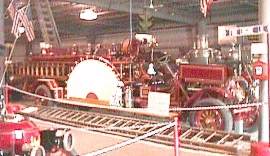 LADDER TRUCK: This 1923 American-LaFrance Hook and Ladder fire
truck was purchased new by the City of Augusta, ME, and used by
their fire department until the late 1950s. It served as a
training tool by the Job Corps at Poland Spring, ME in the mid
60s and was owned privately and restored most recently by the Old
Port Hook and Ladder Co. of Portland, ME who donated it in
1988.It is classified as a Type "14" City Ladder
Service Truck. Its primary purpose in fire fighting was to haul
hooks, ladders and tools to the fire scene. It carries, among its
equipment, a life net; fire extinguishers; roof, wall, and
extension ladders; pike poles; fire axes and shovels; and
kerosene lanterns. Originally,
LADDER TRUCK: This 1923 American-LaFrance Hook and Ladder fire
truck was purchased new by the City of Augusta, ME, and used by
their fire department until the late 1950s. It served as a
training tool by the Job Corps at Poland Spring, ME in the mid
60s and was owned privately and restored most recently by the Old
Port Hook and Ladder Co. of Portland, ME who donated it in
1988.It is classified as a Type "14" City Ladder
Service Truck. Its primary purpose in fire fighting was to haul
hooks, ladders and tools to the fire scene. It carries, among its
equipment, a life net; fire extinguishers; roof, wall, and
extension ladders; pike poles; fire axes and shovels; and
kerosene lanterns. Originally,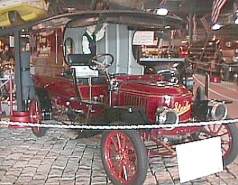 it was equipped with mechanical brakes.
Later, hydraulic brakes were installed as a safety feature. The
truck is in running condition and fire fighters described the
sound of its engine as particularly beautiful. American-LaFrance
apparatus of this vintage were referred to as the Rolls-Royce of
fire trucks due to their similar appearance from the firewall
forward and the quality of the workmanship.
it was equipped with mechanical brakes.
Later, hydraulic brakes were installed as a safety feature. The
truck is in running condition and fire fighters described the
sound of its engine as particularly beautiful. American-LaFrance
apparatus of this vintage were referred to as the Rolls-Royce of
fire trucks due to their similar appearance from the firewall
forward and the quality of the workmanship.
THE STANLEY STEAMER: Francis E. and Freelan O. Stanley (identical
twins) built the first three Stanley Steamers in 1897-98 in
Newton, MA using engines built in Mechanic Fall, ME. The third
was sold in 1898. Their company was known as the Stanley Motor
Carriage Co. which they sold to John Walker (Cosmopolitan
magazine) and Amzi Barber (the "Asphalt King") who
changed the name to Locomobile. the Stanley Bros. purchased that
company in 1902 and continued to manufacture their steamers. This
authentic 1913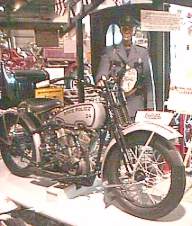 10 HP bread delivery truck was acquired from
Carl "Stanley" Amsley who restored it to its present
condition. Its cargo area has been reconfigured to accommodate
passengers. According to Amsley, there is only one other of these
models and it is in Brussels, Belgium. The Stanleys were born in
Kingfield, ME.
J.D. HARLEY-DAVIDSON: This 1926 is nearly identical to those
first acquired for the Maine State Police in 1925. Their picture
is below and identification is being researched. They were
discontinued after World War II though two were saved and used in
parades until late 1940s. 74 cu. in. twin. A Museum acquisition
in 1994. Restored
PRAIRIE SCHOONER: The first train of prairie schooners left
Missouri and made
10 HP bread delivery truck was acquired from
Carl "Stanley" Amsley who restored it to its present
condition. Its cargo area has been reconfigured to accommodate
passengers. According to Amsley, there is only one other of these
models and it is in Brussels, Belgium. The Stanleys were born in
Kingfield, ME.
J.D. HARLEY-DAVIDSON: This 1926 is nearly identical to those
first acquired for the Maine State Police in 1925. Their picture
is below and identification is being researched. They were
discontinued after World War II though two were saved and used in
parades until late 1940s. 74 cu. in. twin. A Museum acquisition
in 1994. Restored
PRAIRIE SCHOONER: The first train of prairie schooners left
Missouri and made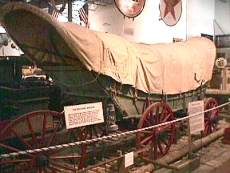 the 2,000 mile trip to the Oregon Territory
in 1843. They were called schooners because of their resemblance
to small ships when seen from a distance, pitching and swaying
with their white canvas tops billowing in the wind as they
crossed the waving, grassy prairie. The only roads were wagon
tracks. There were no bridges but an occasional makeshift ferry
would be encountered. Journeys took months and were fraught with
trouble and delays. Schooners were of many sizes; some required
four, six, or eight pairs of horses, oxen or mules and some, as
this unit reveals, were drawn by a team of two horses. This unit
was never used in Maine but purchased by Charles Stickney,
Deering Ice Cream, Portland about 1980 at a Lancaster, PA
auction. He intended to use it in parades but found it difficult
to find suitable horses so it was stored until donated to this
museum in 1989.
Of course I couldn't fail to add this camper tent trailer which
was
the 2,000 mile trip to the Oregon Territory
in 1843. They were called schooners because of their resemblance
to small ships when seen from a distance, pitching and swaying
with their white canvas tops billowing in the wind as they
crossed the waving, grassy prairie. The only roads were wagon
tracks. There were no bridges but an occasional makeshift ferry
would be encountered. Journeys took months and were fraught with
trouble and delays. Schooners were of many sizes; some required
four, six, or eight pairs of horses, oxen or mules and some, as
this unit reveals, were drawn by a team of two horses. This unit
was never used in Maine but purchased by Charles Stickney,
Deering Ice Cream, Portland about 1980 at a Lancaster, PA
auction. He intended to use it in parades but found it difficult
to find suitable horses so it was stored until donated to this
museum in 1989.
Of course I couldn't fail to add this camper tent trailer which
was 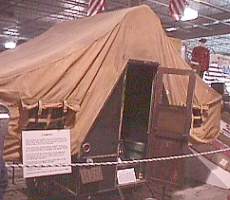 manufactured
by the Chenango Equip. Mfg. Co., Norwich, NY in 1925 and sold by
the Jones & VanDoran Motor Camping outfitters in New York
City for $348. The wheels are "wood artillery wheels"
revolving on Timkin bearing with Model T tires. The springs and
wheels are interchangeable with Model T parts. The body is 24 ga.
metal with a steel reinforced basswood tent frame. It weighs
about 900 lbs including its beds, ice-box, stove, stove hood and
full length benches. It traveled an average of 1,800 miles each
of the summers between 1946 and 1961.
I was very impressed with the museum and its content but even
more so at the dedication that a commercial company has to the
community that supported their growth. If you ever get through
Bangor, Maine, be sure and stop by for a visit. They are open:
May 1-Nov 11, seven days a week. For further information check
out their website at: http://www.colemuseum.com
or give them a call at: 207-990-3600.
manufactured
by the Chenango Equip. Mfg. Co., Norwich, NY in 1925 and sold by
the Jones & VanDoran Motor Camping outfitters in New York
City for $348. The wheels are "wood artillery wheels"
revolving on Timkin bearing with Model T tires. The springs and
wheels are interchangeable with Model T parts. The body is 24 ga.
metal with a steel reinforced basswood tent frame. It weighs
about 900 lbs including its beds, ice-box, stove, stove hood and
full length benches. It traveled an average of 1,800 miles each
of the summers between 1946 and 1961.
I was very impressed with the museum and its content but even
more so at the dedication that a commercial company has to the
community that supported their growth. If you ever get through
Bangor, Maine, be sure and stop by for a visit. They are open:
May 1-Nov 11, seven days a week. For further information check
out their website at: http://www.colemuseum.com
or give them a call at: 207-990-3600.
Good Luck! Have Fun! and Stay Safe!
Laura
